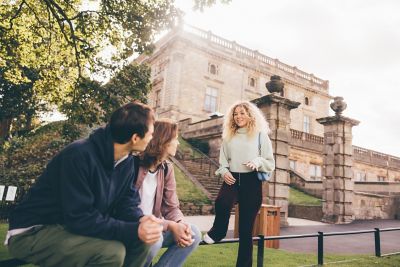Medieval Studies at Nottingham
Bring history to life. From caves to prisons to England's oldest inn, Nottingham has plenty of medieval places to explore.

When you study English with us, you'll learn about more than language and literature.
You will explore five key areas, discovering everything from Vikings, to creative writing, to drama, before being able to specialise later on in your degree.
Our five key areas are:
Medieval studies is a new English topic for many of our students. So where better to get acquainted than in the medieval city of Nottingham?
Learn about Old and Middle English literature, Viking history, and medieval culture with a backdrop of Robin Hood, the myths, legends and landmarks. Here are just a few of the historical landmarks our city has to offer:
Built in the 11th century, the castle played a significant role in the English Civil War. Today, the castle museum showcases the city and its community, including our famed Nottingham lace, an extensive art gallery, and early Nottingham crafts.
Your ticket also includes entrance to the caves, and the Brewhouse Yard Museum at the foot of the castle.

The Robin Hood statue outside Nottingham Castle
This historic building served as a courthouse and prison during the medieval period. You can explore the Victorian Courtroom, Georgian gaol, and ancient cells, getting an insight into the legal system and punishments of the time.
If you're feeling adventurous, they also host murder mystery events and ghost tours!

Image courtesy of the National Justice Museum
This ancient woodland was a royal hunting ground in medieval times and is the
legendary home of Robin Hood and his band of Merry Men.
Nowadays, you can explore the forest on your own, or take part in one of the many seasonal events - from joining a hygge nordic walk, stargazing, or trying your hand at willow weaving.

Major Oak tree at Sherwood Forest. Image courtesy of Tammy Herd
The medieval St Mary's Church, located in the Lace Market area, is one of
Nottingham's oldest surviving buildings. It dates back to the 14th century and
showcases architectural features of that era. It is also home to the oldest door in Nottingham!
Students are welcome to join the weekly services, volunteer, ot take part in their occasional courses and talks.

Outside St Mary's Church. Image courtesy of St Mary’s in the Lace Market
Below Nottingham there is an extensive network of natural caverns, and man-made caves carved from sandstone, dating back to at least the medieval period.
They have served various purposes over the centuries - including dwellings, storage spaces, pub cellars, tanneries, air-raid shelters, and even as medieval dungeons and hideouts!

Inside one of the many caves. Image courtesy of The City of Caves
Goose Fair has medieval origins and is one of the oldest and most famous traveling fairs in England. It dates back to the 13th century and was initially a trade event for livestock and goods. It runs annualy in late September/early October.

Nottingham students riding the carousel at Goose Fair
Located beneath Nottingham Castle, the pub claims to have been established in 1189, making it one of England's oldest inns. It is said that Crusaders who passed through the region would stop at the inn before their journey to the Holy Land. The basement of the pub includes a series of caves, connecting it to Nottingham Castle, which were once used as part of the jail.
If it's your thing, the Original Nottingham Ghost Walk starts here Saturday evenings at 7pm.

Outside the Inn. Image courtesy of Bookitlist
Newstead Abbey was originally a monastic house founded in the 12th century. After the dissolution of the monasteries, it was transformed into a grand country house. It is famously associated with the poet Lord Byron, who lived here for a time in the early 19th century.

Newstead Abbey grounds and lake. Image courtesy of David Reed
With the scene set, immerse yourself in study with our research-led teaching. Here's what our students say about our modules:

Learning about Vikings was something I didn’t know I would thoroughly enjoy until I tried it as an optional module in first year. From depicting the many biases and perspectives towards the Vikings, to the associations between Old Norse and Viking beliefs, there was always a topic, quote, image or historical object from every lecture that would intrigue me!
Charlotte
English BA
We have experts in Old Norse, Viking Studies, Early English, Name-studies, historical language, and health humanities.

My main research area is health and disease.There's an often erroneous idea that people in the Middle Ages didn't get medical attention or, if they got medical attention, it was useless. And that’s not true.
Christina Lee
Associate Professor in Viking Studies

In terms of the city, we are in the heart of the Danelaw, so Nottingham is one of what's called the 'Five Boroughs'. These were five towns that were ruled by the Vikings in the 9th and 10th centuries.
Judith Jesch
Professor of Viking Studies

My research covers late Middle English and Older Scots Literature and Book History. I have particular interests in the poetry of Chaucer and Gower, in Older Scots poetry and prose, in lyric writing in the medieval and early modern period, and in editing medieval and early modern texts.
Jo Martin
Associate Professor in Middle English and Older Scots